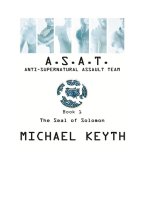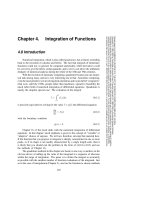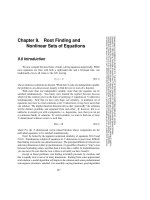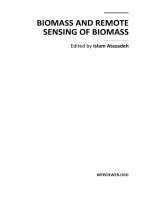Book of Biology, Part 1: Vertebrata, by H. G. Wells pot
Bạn đang xem bản rút gọn của tài liệu. Xem và tải ngay bản đầy đủ của tài liệu tại đây (4.55 MB, 618 trang )
The Project
Gutenberg eBook,
Text Book of
Biology, Part 1:
Vertebrata, by H.
G. Wells
This eBook is for the use of anyone
anywhere at no cost and with
almost no restrictions whatsoever. You may
copy it, give it away or
re-use it under the terms of the Project
Gutenberg License included
with this eBook or online at
www.gutenberg.org
Title: Text Book of Biology, Part 1:
Vertebrata
Author: H. G. Wells
Release Date: June 8, 2007 [eBook
#21781]
Language: English
Character set encoding: ISO-8859-1
***START OF THE PROJECT
GUTENBERG EBOOK TEXT BOOK OF
BIOLOGY, PART 1: VERTEBRATA***
E-text Prepared by "Teary
Eyes" Anderson
E-text prepared by "Teary Eyes"
Anderson
and Dedicated To Destanie;
With Hopes Her Dream of Becoming A
veterinarian Comes True
Special Thanks to Deborah Furness of the
University College London for her help,
and research, in learning about this book,
and helping me understand it better. Spell-
checked with www.thesolutioncafe.com
Transcriber's Note:
I try to edit my e-texts so they can easily
be used with voice speech programs, I
believe blind people and children should
also be able to enjoy the many books now
available electronically. I use the for an
em-dash, with a space either before or
after it depending on its usage. This helps
to keep certain programs from squishing
the words together, such as down-stairs.
Also to help voice speech programs I've
enclosed upper case text between - and _
(-UPPER CASE TEXT_), and used
underscores to show chapter and section
headers. I also added a second contents
that shows the other sections of this e-text.
This e-text was made with a "Top can"
text scanner, with a bit of correcting here
and there.
This book is volume one of two. It was
later reworked by A. M. Davies in 1898
under the title "Text-book of Zoology",
then revised and rewritten by J. T.
Cunningham about 1909 and W. H. Leigh-
Sharpe around 1932. Although these
editions gave Wells the main credit, most
of Wells' writing and all his drawings
were removed; only his rough outline
seems to have been used. It was re-
published by University Tutorial Press.
The First Edition, as well as The Second
and Revised Edition (with dissections
redrawn by Miss A. C. Robbins) are used
in this e-text. The First Edition had some
small minor errors, as well as dissection
abbreviations that are shown on the
Dissection Sheets, but no mention of them
was listed in the text. Certain figures on
the Dissections Sheets are missing (such
as Figures 1, 2, 4, with no mention to a 3,
as if Mr. Wells drew a Figure 3 but found
it was not needed and removed it from the
book). Rather then leaving it as is, I put {}
marks around my notes saying things like
{No Figure 3}. For the "Second and
Revised Edition" Wells was able to
change some of these errors and missing
parts, but many of the same printing tablets
were used and with almost each addition
other things were removed, (in one
instance one entire section from a
chapter), and many of the helpful
suggestions were shortened or removed so
other things could be explained more. In
an ideal version of the book both could
have been used, but with reprinting the
entire book from the first to the second
editions almost as many things were lost
as were gained, so I've tried to indicate
where both text go separate paths with the
following;
[Second Edition only text] and -First
Edition only text,- and also
{Lines from Second Edition only.}
and {Lines from First Edition only.}
where more than just a sentence is added
or removed. Other things to notice is how
some words are spelt or punctuated
differently throughout the book, such as;
Blood Vessels
Blood-Vessels
Bloodvessels
I've tried to keep these as close to the
original book as possible.
University Correspondence
College Tutorial Series.
Biology._
by
H. G. Wells,
Bachelor of Science,
London., Fellow of the
Zoological Society.
Lecturer in Biology at
University Tutorial College.
With An Introduction by G.
B. Howes,
Fellow of the Linnean Society, Fellow of
the Zoological Society.
Assistant Professor of Zoology, Royal
College of Science, London.
Part 1 Vertebrata.
Contents
Introduction
Preface
The Rabbit
1.
External Form and General
Considerations
2. The Alimentary Canal of the Rabbit
3. The Circulation
4. The Amoeba, Cells and Tissue
5. The Skeleton
6. Muscle and Nerve
7. The Nervous System
8. Renal and Reproductive Organs
9. Classificatory Points
10.
Questions and Exercises
The Frog
1. General Anatomy
2.
The Skull of the Frog
(and the Vertebrate Skull generally)
3.
Questions on the Frog
The Dog-Fish
1. General Anatomy
2.
Questions on the Dog-Fish
Amphioxus
1. Anatomy
2. The Development of Amphioxus
3.
Questions on Amphioxus
Development
The Development of the Frog
The Development of the Fowl
The Development of the Rabbit
The Theory of Evolution
Questions on Embryology
Miscellaneous Questions
Note on Making Comparisons
Syllabus of Practical Work
{Contents part 2}
Key for Dissection Sheets, and
Abbreviations
-Introduction_
In the year 1884 I was invited to give
tuition by correspondence, in Biology.
Although disposed at the time to ridicule
the idea of imparting instruction in natural
science by letter, I gladly accepted the
opportunity thus afforded me of
ascertaining for myself what could and
could not be accomplished in that
direction. Anyone familiar with the scope
of biological enquiry, and the methods of
biological instruction, will not need to be
reminded that it is only by the most
rigorous employment of precise directions
for observation, that any good results are
to be looked for at the hand of the
elementary student. True to this principle,
I determined to issue to my
correspondence pupils rigid instructions,
and to demand in return faithful annotated
drawings of facts observed in their usage.
In the case of two among the few students
who passed through my hands, the result
far exceeded my most sanguine
anticipations. The notes sent in by one of
them a man working at a distance, alone
and unaided far excelled those wrung
from many a student placed under the most
favourable surroundings; and their
promise for the future has been fulfilled to
the utmost, the individual in question
being now a recognised investigator. It
thus became clear that, not-with-standing
the complex conditions of work in the
biological field, tuition by
correspondence would suffice to awaken
the latent abilities of a naturally qualified
enquirer. The average members of a
University Correspondence Class will be
found neither better nor worse than those
of any other, and they may therefore pass
unnoticed; if however, the correspondence
system of tuition may furnish the means of
arousing a latent aptitude, when the
possibilities of other methods of approach
are excluded and in so doing, of
elevating the individual to that position for
which he was by nature qualified,
ensuring him the introduction to the one
sphere of labour for which he was born
it will have created its own defence, and
have merited the confidence of all right-
thinking people. The plucking of one such
brand from the burning is ample
compensation for the energy expended on
any number of average dullards, who but
require to be left alone to find their natural
level.
Mr. Wells' little book is avowedly
written for examination purposes, and in
conformity with the requirements of the
now familiar "type system" of teaching.
Recent attempts have been made to
depreciate this. While affording a
discipline in detailed observation and
manipulation second to that of no other
branch of learning, it provides for that
"deduction" and "verification" by which
all science has been built up; and this
appears to me ample justification for its
retention, as the most rational system
which can be to-day adopted. Evidence
that its alleged shortcomings are due
rather to defective handling than to any
inherent weakness of its own, would not
be difficult to produce. Although rigid in
its discipline, it admits of commentatorial
treatment which, while heightening the
interest of the student, is calculated to
stimulate alike his ambition and his
imagination. That the sister sciences of
Botany and Zoology fall under one
discipline, is expressed in the English
usage of the term "Biology." Experience
has shown that the best work in either
department has been produced by those
who have acquired on all-round
knowledge of at least the elementary
stages of both; and, that the advanced
morphologist and physiologist are alike
the better for a familiarity with the
principles not to say with the
progressive advancement of each other's
domain, is to-day undeniable. These and
other allied considerations, render it
advisable that the elementary facts of
morphology and physiology should be
presented to the beginner side by side a
principle too frequently neglected in
books which, like this one, are specially
written for the biological neophyte.
Although the student is the wiser for the
actual observation of the fact of nature, he
becomes the better only when able to
apply them, as for example, by the
judicious construction of elementary
generalizations, such as are introduced
into the pages of this work. So long as
these generalizations, regarded as first
attempts to deduce "laws" in the form of
"generalized statement of facts based
observation," are properly introduced into
an elementary text-book, intended for the
isolated worker cut off from the lecture
room, their intercalation is both healthy
and desirable.
Mr. Wells has kept these precepts
constantly in mind in the preparation of his
work, and in the formulation of his plans
for its future extension, thereby enhancing
the value of the book itself, and at the
same time, discouraging the system of
pure cram, which is alien to the discipline
of biological science.
B. Howes
College of Science,
Kensington;
30, 1892.
-Preface_
No method of studying more especially









